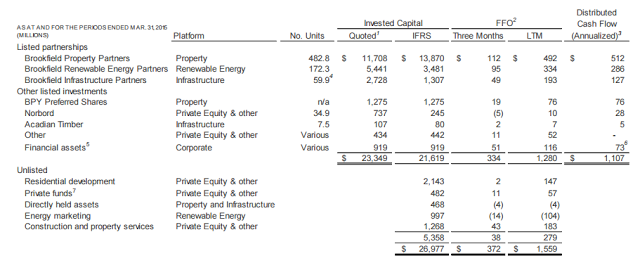Brookfield Asset Management (BAM.A)
This name has been mentioned on this blog a few times in the comments section, but I never wrote about it. It is well known in the value investing community and I said I'll make a post about it in the near future so here it is.
First of all, BAM is sort of an outsider/owner-proprietor business as it has been run for a long time by a single CEO, and the great track record is attributed to him.
Story Fits Too Much
The only thing that I am not so excited about in recent years is that the story sort of fits the environment a little but too much; pension funds and others need to increase returns to be able to make obligations, with interest rates low and stock market scary people need alternative investments. With the perception of higher risk (or high cost, low return) of hedge funds and private equity funds, fear of future inflation due to global perpetual pump-priming (global PPP?), hard or real assets and real asset managers look really, really interesting.
Oftentimes, when everything is just too perfect, the investment doesn't pan out. So that's what I've sort of been worried about. Plus, honestly, I've never really been a big fan of commercial real estate. There have been some great wealth created in real estate for sure, and it's a solid investment if you have good people investing. But it's just never been something that excited me. Don't tell Ackman I said that, though...
Lou Simpson's Concentrated Bet
What's really interesting is that Lou Simpson bumped up his bet on BAM this year. Lou Simpson probably needs no introduction here, but just in case, he's a portfolio manager that managed GEICO's investments for many years with great results (I think beating Buffett). He now runs SQ Advisors, after retiring from GEICO.
Just as a reminder, here is Simpson's investment performance at GEICO from BRK's 2004 annual report:

And then when he retired at the end of 2010, this is what Buffett wrote in the annual report:

Here is the history of Simpson's BAM holdings in the past year:
shares owned
6/30/2014: 3.8 million
9/30/2014: 4.0 million
12/31/2014: 4.5 million
3/31/2015: 6.8 million
This looks like the effect of a 3/2 split, but that didn't happen until May, so Simpson really bumped up his investment in BAM.
BAM now accounts for a whopping 12.5% of Simpson's portfolio, second only to his Valeant (VRX) position. BAM is also bigger than his positions in BRK and WFC each of which constitute 11.5% of his portfolio. (It is interesting how Munger absolutely deplores VRX (he said it's worse than ITT in the 60's) while it's Simpson's top holding. This is why when people disagree with me, I don't care too much. Even the best and the brightest don't agree on things. Who am I to expect people to agree with me?!)
Anyway, this might have gotten some of your attention.
This also makes this post timely.
And by the way, this is Simpson's current portfolio (as of March 2015):
| NAME OF ISSUER | TITLE OF CLASS | (x$1000) | PRN AMT | PRN |
| BERKSHIRE HATHAWAY INC DEL | CL A | 4,568 | 21 | SH |
| BERKSHIRE HATHAWAY INC DEL | CL B NEW | 333,927 | 2,313,799 | SH |
| BROOKFIELD ASSET MGMT INC | CL A LTD VT SH | 364,970 | 6,810,878 | SH |
| CROWN HOLDINGS INC | COM | 226,804 | 4,198,521 | SH |
| LIBERTY GLOBAL PLC | SHS CL C | 246,015 | 4,939,071 | SH |
| ORACLE CORP | COM | 91,216 | 2,113,921 | SH |
| PRECISION CASTPARTS CORP | COM | 283,949 | 1,352,140 | SH |
| SCHWAB CHARLES CORP NEW | COM | 247,566 | 8,132,923 | SH |
| UNITED PARCEL SERVICE INC | CL B | 154,544 | 1,594,226 | SH |
| US BANCORP DEL | COM NEW | 249,124 | 5,704,686 | SH |
| VALEANT PHARMACEUTICALS INTL | COM | 376,646 | 1,898,540 | SH |
| WELLS FARGO & CO NEW | COM | 334,057 | 6,140,747 | SH |
Back to BAM
Here is the long term performance for BAM from their 2014 annual report:
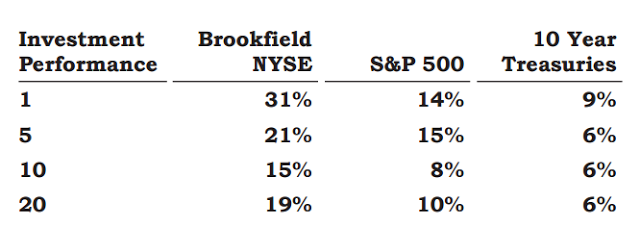
Pretty good, I think.
Presentation
There was an investor day back in September, 2014, so let's take a look at some slides from that presentation. (Check out their website for their annual reports, presentations etc: BAM Investor relations)

There was a 3/2 split in May of this year, so the above share price targets is actually $100 - 130, which corresponds to 12-15% annualized growth from the current price of around $36/share.
They have really diversified on many fronts; geographically, investment vehicles, asset classes etc.

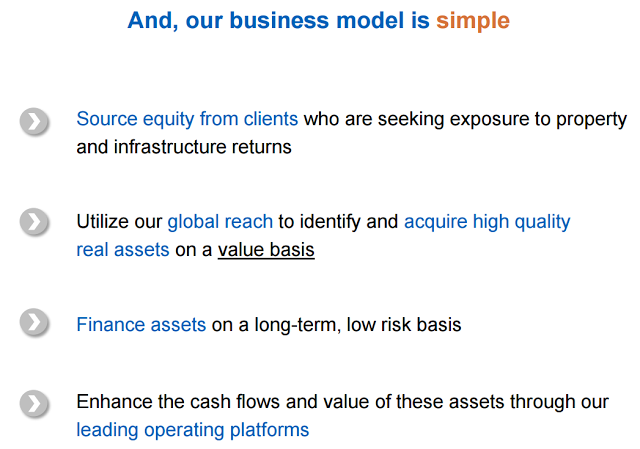
And the fact that they are in so many areas serves as a big advantage for them:
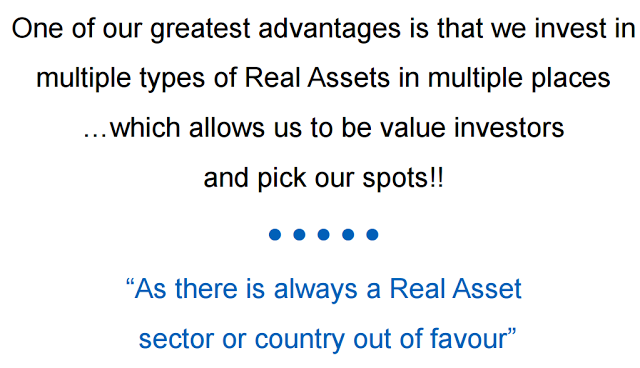
This is a section from their first quarter 2015 report that talks about their culture and why they think they can continue to do well going forward. By the way, critics complain about the lack of disclosure at BAM, but I find their reports to be very informative. How many companies write their quarterly reports almost like annual reports? (in fact, BAM's quarterly reports are better and more thoroughly written and more informative than most annual reports!):
Culture as a Competitive Advantage
We are often asked whether Brookfield can continue to increase the amount of capital we have invested in global opportunities, on a profitable basis. The short answer is that we believe we can.
While acknowledging the normal challenges, we believe we have three distinct competitive advantages which will help us accomplish our goals:
- Team Approach – The first advantage is that over the years, we have invested significant capital and human resources to build out the backbone and support structure of our operations, creating a first-in-class global company. Operating decisions are a culmination of the views of approximately 40 members of the management partnership, our 18 senior managing partners, our 700 investment executives and our more than 28,000 employees. We try to mix entrepreneurship, institutional stewardship, best-in-class professionalism, global scale and localized expertise; all with a focus on generating long-term capital appreciation. Our team approach to our business, the pursuit of excellence and commitment to our colleagues and investment partners drives this success.
- Our Global Reach – Brookfield’s second advantage is the scale and global reach of our operations, enabling us to invest in and manage assets and opportunities across many investment products and jurisdictions, efficiently and effectively. The flexibility to opportunistically invest capital in this manner is rarely possible with smaller firms. We have built a global company operating today in the major cities of the world including London, New York, Sydney, São Paulo, Toronto, Shanghai, Dubai and Mumbai and many other locations. We are diversified: culturally, financially and geographically. As an investor in our company you acquire exposure to global economic and business diversification which few other investments offer.
- A Distinct Culture – The third advantage and possibly our most important is our distinct corporate culture. We have written extensively over the years on our first two advantages, but seldom have we attempted to explain “how” we operate and “why” we believe our culture provides us with an important competitive advantage.
While admittedly it is difficult to define culture precisely (the Oxford Dictionary defines it as “the attitudes and behaviour characteristic of a particular group”), ours is based on the following key principles.
- Principles of Business – Our core fundamental business principles are set out in our annual report and were formed by our early founders, and refined over the years. These principles include: building our business and all our relationships based on integrity, value investing in how we allocate and invest capital, fair-sharing in our relationships and measuring success based on total return on capital over the long term. We are required to report quarterly, but regardless of short-term reported results, our investment focus is always on creating long-term sustainable appreciation on invested capital.
- Personal Financial Commitment – We promote long-term ownership stability and orderly management succession and encourage our senior executives to devote most of their financial resources to investing in Brookfield. As a result, collectively our management partnership owns approximately 20% of Brookfield, which is consistent with our efforts to align our interests with investors and clients throughout the organization.
- Operating as a Partnership – We operate internally as a “true partnership” with long-term investment horizons. Our management partners are highly specialized, but all recognize that by working collaboratively together as a team, we can achieve far more than if we were structured on a more traditional basis.
Our global platform enables us to finance and invest in a wide variety of opportunities, and few asset management firms offer as diverse a platform of specialized investment products. As we look forward to future decades, we believe that we are well positioned to build on our successes.
Asset Management
One of the big drivers in the value of BAM is their asset management business. They have high quality assets on the balance sheet, and at the same time they raise more funds from outside investors and earn management / incentive fees and carried interest and this is really growing. This is the key to the BAM investment.
Importantly, they have performed very well so far:


One chart in the presentation is not so exciting. They talk about the improving environment and then show this chart, but this is not so exciting for people who want to invest in a private equity manager; valuations are high now (so forward returns will be lower). But then again, BAM is not doing conventional LBO's.
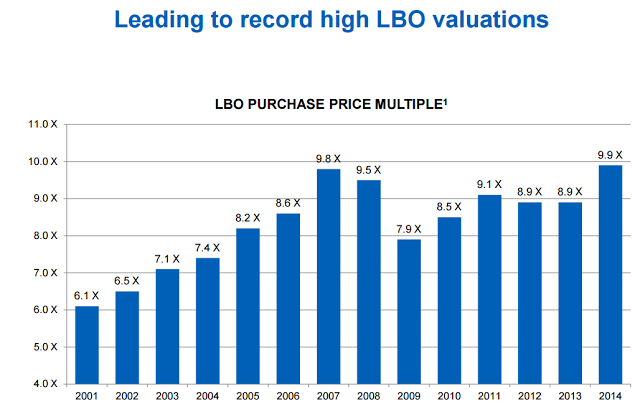
Their AUM continues to grow:
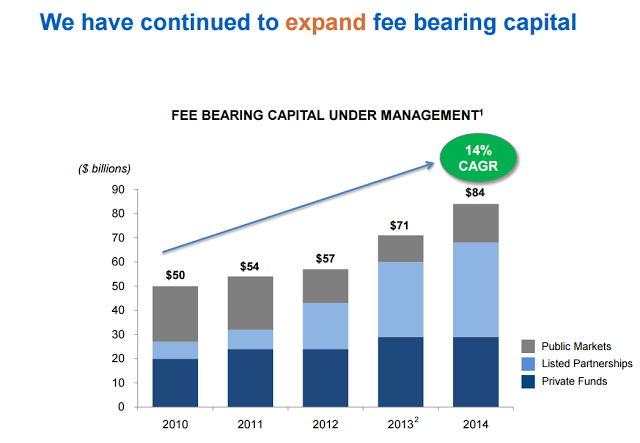
...and a big factor in this investment:
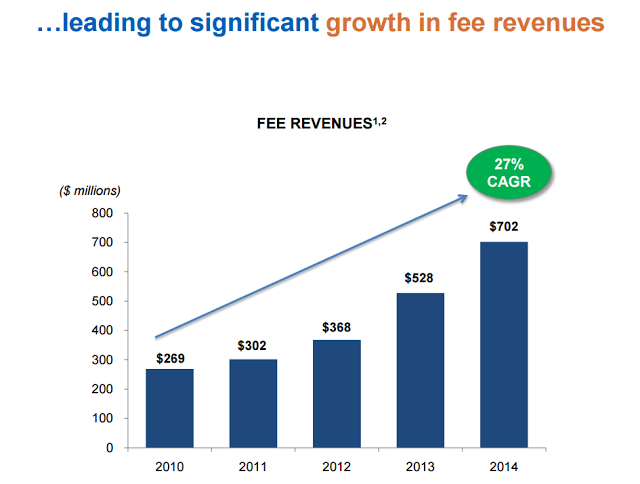

At the 2013 investor day, they said they plan to grow fee bearing assets at a 10%/year rate between 2013-2018. Fee-related earnings was projected to grow +25%/year, target carried interest +18%/year and GP value (value of the asset management business) +20%/year from 2013-2018.
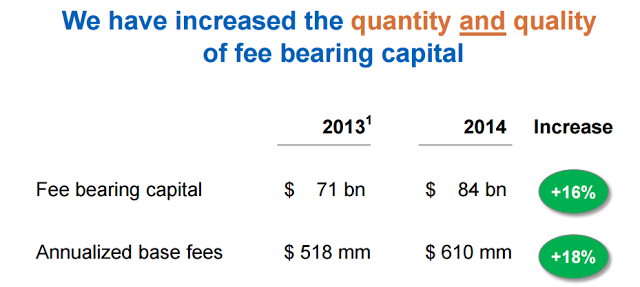
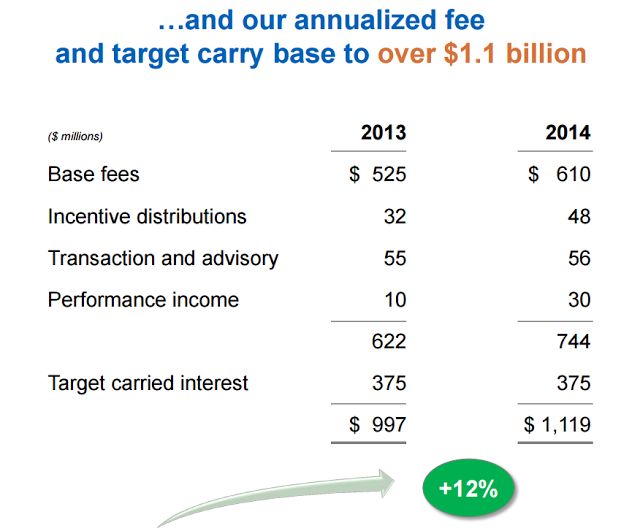
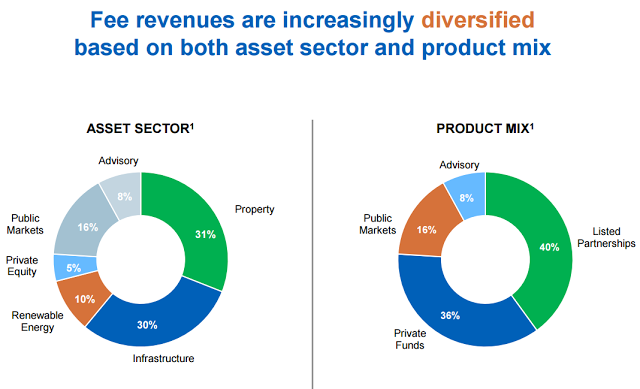
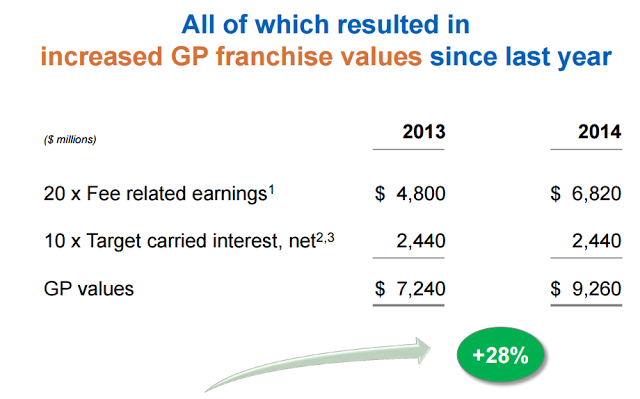
Their value of the asset management business (GP value) grew +28% last year. With 983 million share outstanding at the end of March, 2015, this business is worth around $9.40/share. This value is not reflected on the balance sheet, so adding this to the common equity per share of $19.70/share gets us to a full value of BAM of $29.10/share. Common equity per share may be different from the LP value that BAM uses in presentations, but I used common equity per share as the LP value didn't seem to deduct some corporate things that I wasn't sure about. Common equity per share, in that sense, might be a conservative look.
Big private equity firms seem to be trading these days at something closer to 10x earnings, so using that, BAM's GP value would be more like $6.00/share instead of $9.40/share. Traditional asset managers used to typically trade at 20x P/E, but using 15x P/E would give a GP value of around $8.90/share.
These figures are pretax, though. Many of the listed private equity funds do similar analysis with mostly pretax figures. Since those are partnership units, taxes are paid by the LP unit-holders. You can argue that the conventional asset managers who are valued at 15-20x earnings are valued on after-tax, net income, but the private equity folks will argue back that if those earnings are paid out to shareholders, shareholders would pay taxes on that too, so it is effectively pretax income if you compare it to owning LP units. This is an interesting point. If a corporation doesn't pay a lot of dividends, though, those reinvested earnings wouldn't be taxed at the personal shareholder level (until paid out later, or until capital gains are realized).
Anyway, BAM was trading between $34-38/share when Simpson added to his holdings in the first quarter.
BAM marks their assets to fair value in accordance with IFRS, and this value may differ from the publicly traded prices of the listed entities. A reconciliation of this is shown in the quarterly report so you can make adjustments there.
Here it is:
Maybe BAM is worth a little bit more using market prices rather than IFRS fair value.
BAM expects to grow fee bearing capital 10%/year through 2019.

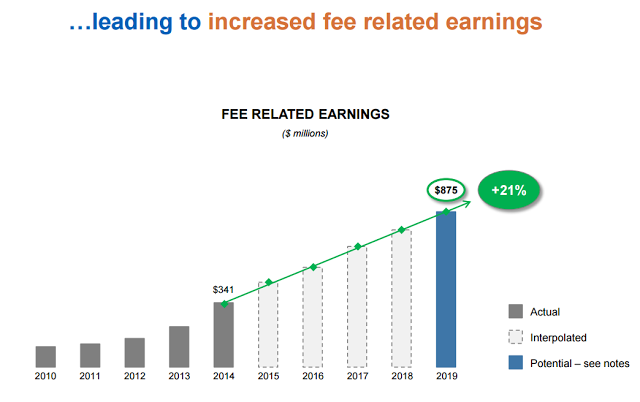


Using BAM's valuation, the asset management business could be worth more than $21/share by 2019. At 10x earnings, it would be worth $13/share or so, and at 15x, $19.50/share.
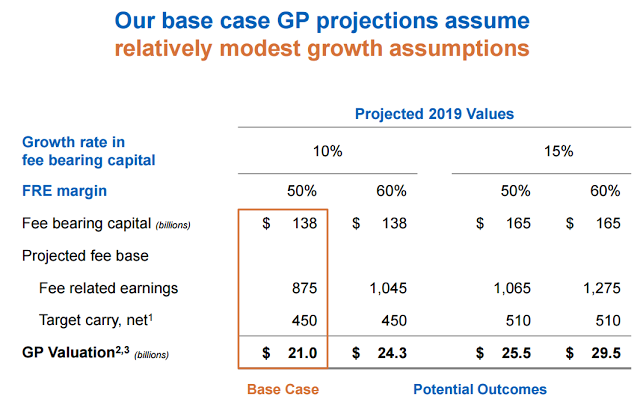
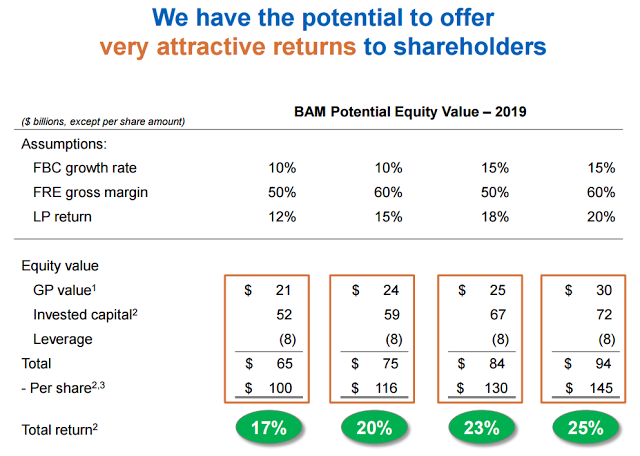
If BAM does better than the base case, it can be worth a lot more. The above per share figures are before the split, so after the split, the above per share values would be $67, $77, $87, and $97, versus the current $36/share.
IFRS Fair Market Valuation
There was some criticism of BAM because they switched to fair market accounting saying that a lot of the gains in recent years have been due to BAM just marking their positions up. Also, there was a time that some listed entities were trading below where it is marked on the balance sheet; critics said that these positions had to be marked down.
But this isn't really a big issue. BAM, before going to fair market value, used to show what they thought everything was worth in their reports and many investors looked at them. Yes, there is some management judgement involved here. But traditional book value has problems too.
What's good about BAM is that they show you how they derive their fair market valuations.
Just to make sure they aren't marking things up with 2% cap rates, look at the assumptions used. You can find this in their reports.
You really can't tell if these discount and cap rates are fair without really knowing the properties, but you can see that they aren't all that low given 2.5% bond yields. These look pretty, 'normal'.
Real estate

Renewable Energy

Infrastructure

Interest Rates
Pretty much everyone expects higher interest rates to come. This will (if accompanied by a stronger economy) help banks and other financials, but it might hurt BAM.
I see BAM (the funds) as sort of more fixed income substitute than a substitute for equity. People who have large fixed income portfolios tend to get into real estate, infrastructure, utility stocks and things like that; low volatility, steady-income-stream type investments. I don't think people go, "gee, the stock market looks dear, I'm buying commercial real estate!". It's more like, "gee, interest rates are too low... let's get into an infrastructure fund as stocks and hedge funds are too volatile for us...".
So in that sense, BAM is prone to a double-whammy. Rising interest rates may push up cap rates (reducing values), and may slow the flow of funds into their funds (or even outflows).
This is true for stocks, too, to a certain extent, but I have shown in an earlier post that even if interest rates went back up to 6%, the stock market now wouldn't be out of line valuation-wise going back 30+ years.
I don't have that sort of confidence in this asset class. Well, BAM is pretty diversified so it's not in any single asset class, but it is sort of the 'real asset' type stuff.
But even for real assets, as you can see from the above discount and cap rates that BAM uses, there is probably a big cushion against rising interest rates.
At the 2013 investor day, they showed a chart of cap rates against interest rates and showed that there is a substantial cushion between the two, just like I showed in stocks.
Check out this chart:
From 2013 investor day presentation
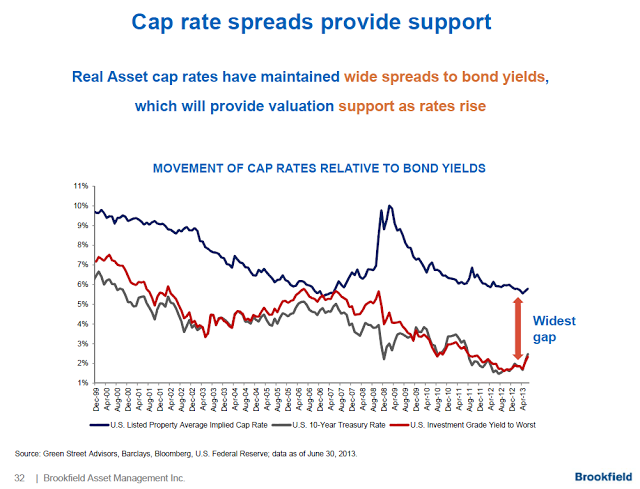
But that doesn't mean there won't be some upward pressure on cap rates when rates really start rising in a serious way.
The Good Part
On the other hand, Bruce Flatt has proven himself to be a very competent manager, and Lou Simpson seems to be buying into this in a big way (Murray Stahl has been a fan for a while too). BAM is on the right side of all sorts of trends, whether it be capital moving to alternatives (CALPERS notwithstanding!), potential (or inevitable) inflation coming down the line due to Global PPP (so real assets == good), potential growth in emerging markets, pent up need for infrastructure invesments etc...
And this management seems to adjust to changing circumstances, so if you own BAM, you don't have to worry about this being a shoot-and-forget, static investment. Even if your position in BAM doesn't change, you can be sure that BAM management will adjust to the ever-changing world; they are not inflexible, unadjusting automatons (like so many large companies seem to be)...






